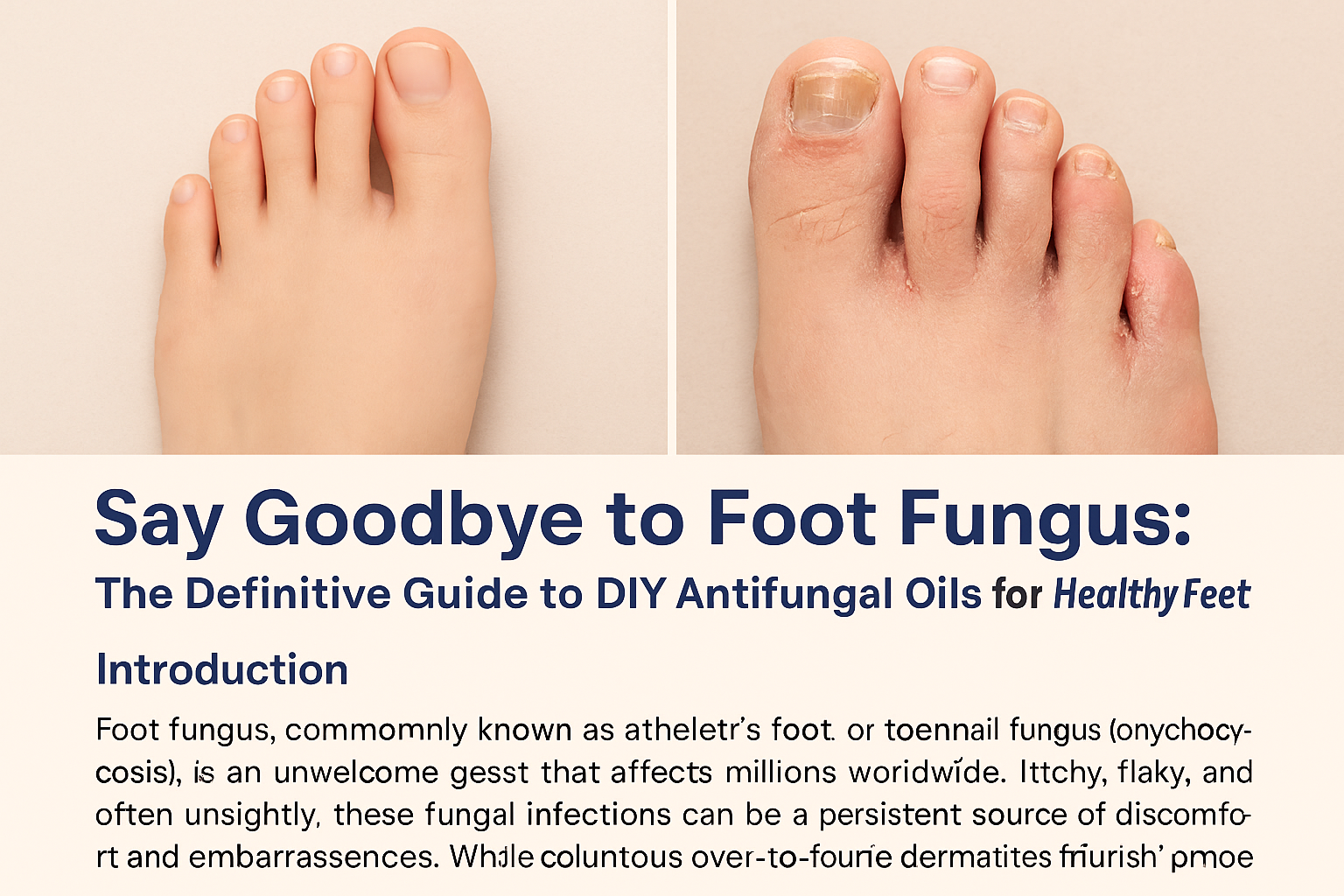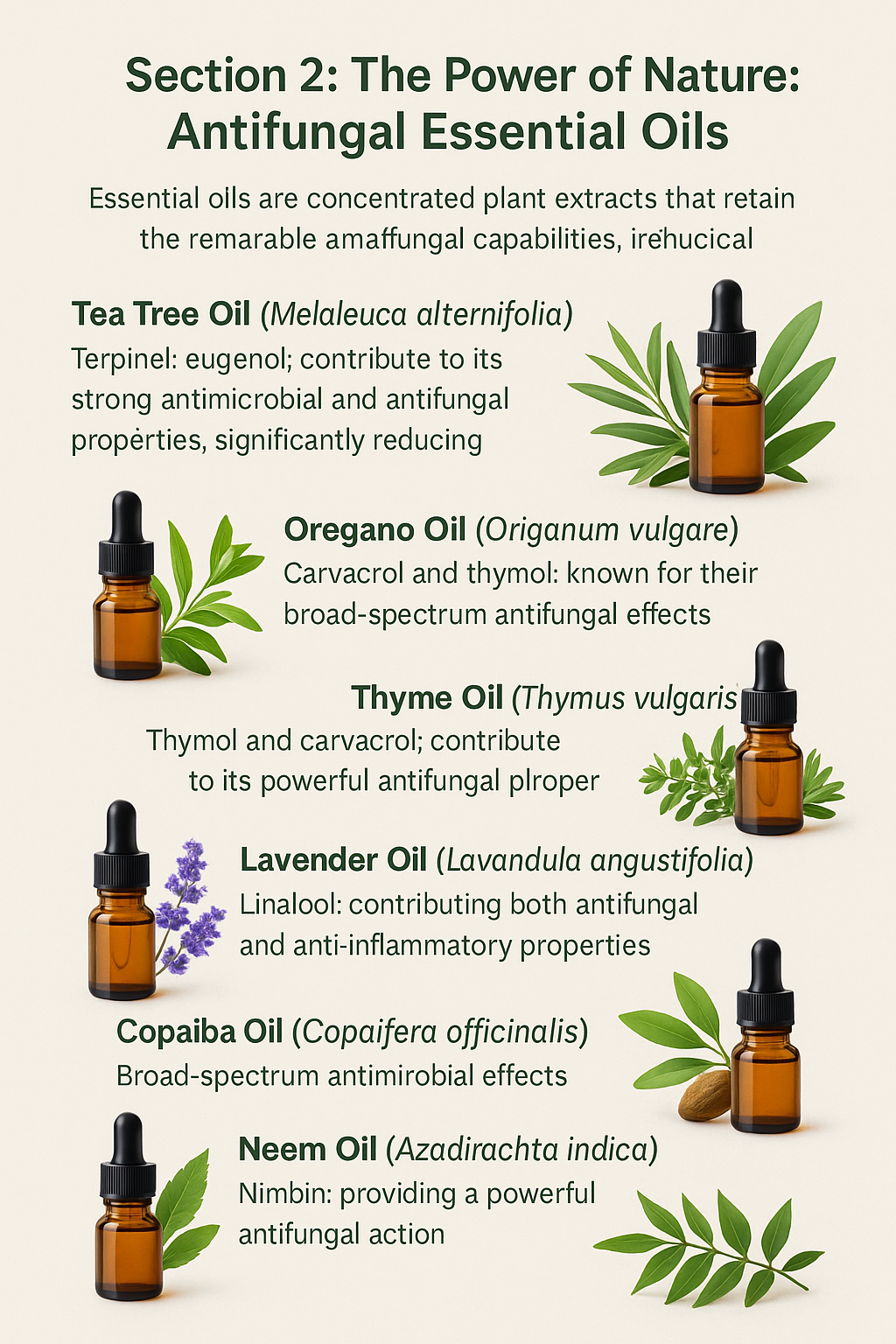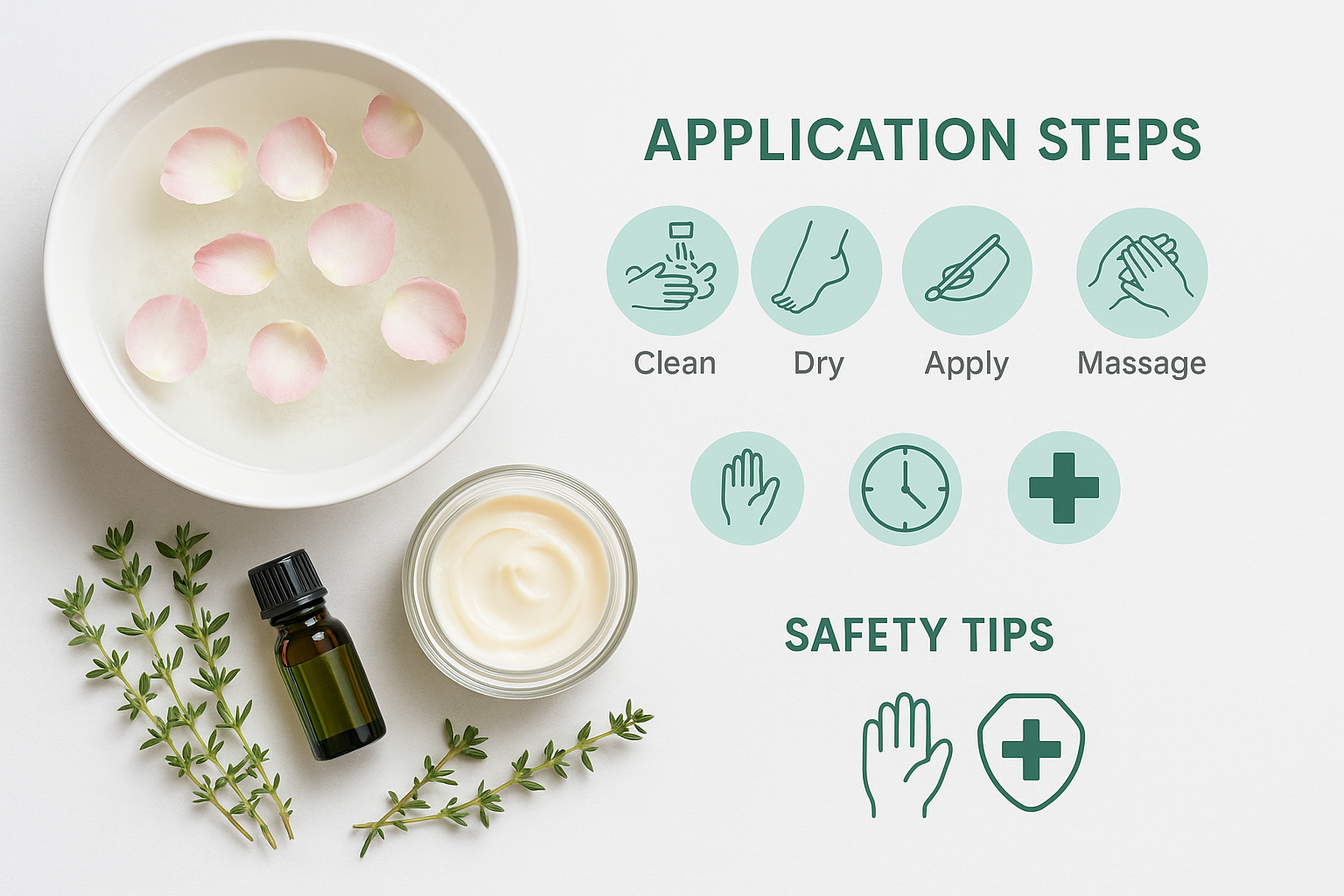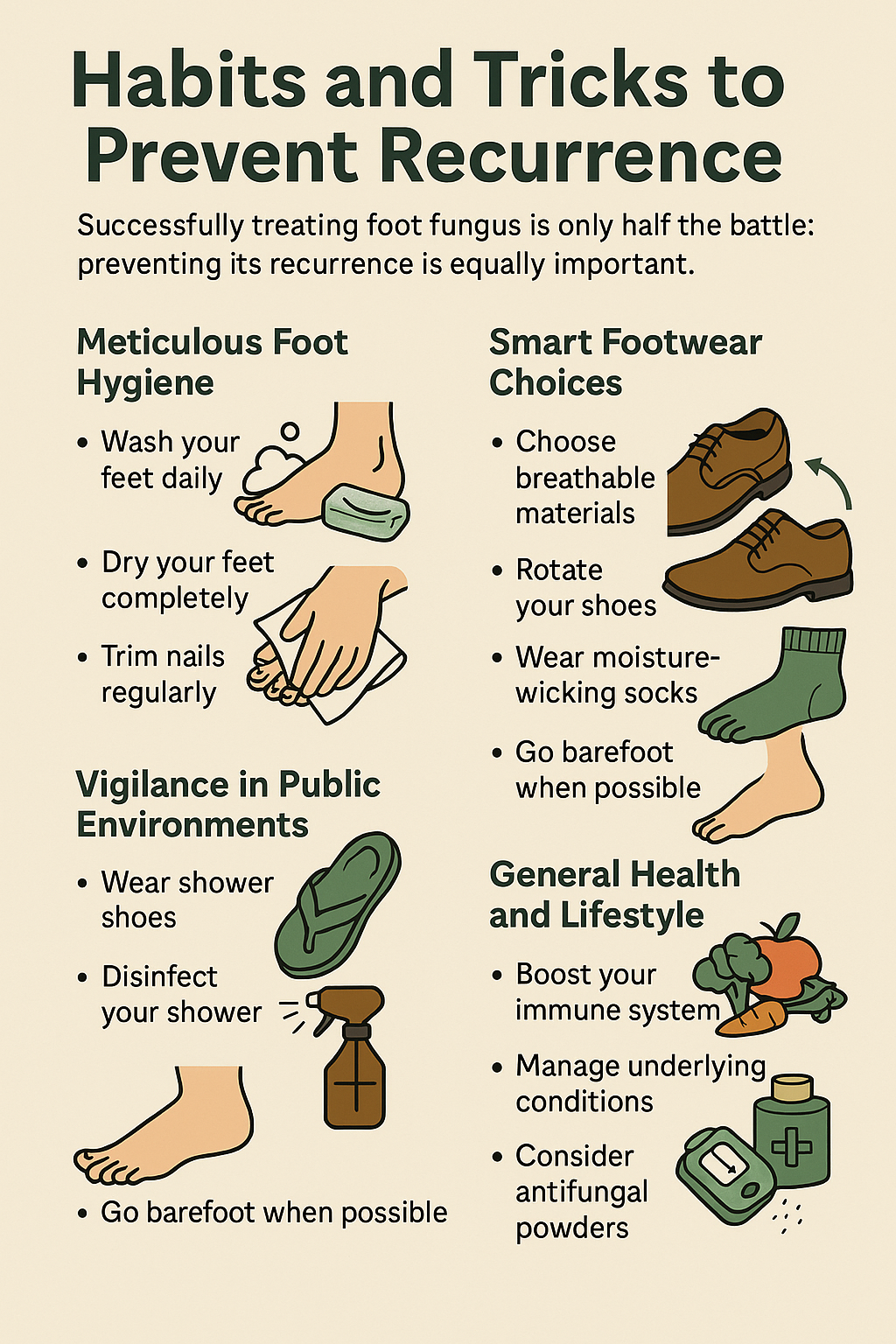Say Goodbye to Foot Fungus: The Definitive Guide to DIY Antifungal Oils for Healthy Feet

Introduction
Foot fungus, commonly known as athlete's foot or toenail fungus (onychomycosis), is an unwelcome guest that affects millions worldwide. Itchy, flaky, and often unsightly, these fungal infections can be a persistent source of discomfort and embarrassment.
While countless over-the-counter remedies promise quick fixes, many individuals are turning to natural, DIY solutions, seeking effective alternatives with fewer side effects.
This comprehensive guide delves into the world of antifungal essential oils, offering practical, home-based strategies to combat foot fungus and reclaim healthy, happy feet. We'll explore the science behind these powerful botanicals, provide detailed DIY recipes, and share essential precautions to ensure safe and effective use.
However, it's crucial to understand that natural treatments, while potent, demand consistency and time. For those moments when life gets in the way, and you need a more convenient, yet equally effective solution, we also invite you to explore our top 3 recommended supplements for foot fungus, offering a powerful alternative to complement your natural health journey.
Section 1: Understanding Foot Fungus and Why It Appears
Foot fungus refers to a group of fungal infections that primarily affect the feet, including the skin, nails, and in some cases, even the hair. The most common forms are athlete's foot (tinea pedis) and toenail fungus (onychomycosis). These infections are caused by various types of fungi, predominantly dermatophytes, which thrive in warm, moist environments. Less commonly, yeasts can also be responsible for fungal infections.
What is Athlete's Foot (Tinea Pedis)?
Athlete's foot is a contagious fungal infection that typically begins between the toes. It can also spread to the soles of the feet and even the hands. Symptoms often include itching, stinging, and burning sensations. The skin may appear red, scaly, cracked, or blistered. In severe cases, the skin can peel, leading to raw, exposed areas that are prone to bacterial infections.
What is Toenail Fungus (Onychomycosis)?
Onychomycosis is a fungal infection of the toenails (and sometimes fingernails). It can cause the nail to become discolored (yellow, brown, or white), thickened, brittle, and crumbly. Over time, the infected nail may separate from the nail bed, causing pain and an unpleasant odor. This type of infection is often more challenging to treat due to the nail's hard, protective barrier.
Causes and Risk Factors
- Moisture and Warmth: Fungi thrive in damp, warm environments. Sweaty feet, tight-fitting shoes, and humid climates create ideal breeding grounds.
- Poor Foot Hygiene: Not washing or drying your feet properly, especially between the toes, encourages fungal growth.
- Closed and Non-Breathable Footwear: Shoes that trap heat and moisture make it easy for fungi to thrive — especially if worn daily without airing.
- Weakened Immune System: Individuals with diabetes or other immune-compromising conditions are more susceptible.
- Minor Skin or Nail Injuries: Small cracks or cuts provide perfect entry points for fungi.
Understanding these causes and risk factors is the first step toward effectively combating and preventing foot fungus. In the next section, we’ll explore how natural essential oils can be a powerful ally in this fight.
Section 2: The Power of Nature – Antifungal Essential Oils
Essential oils are concentrated plant extracts that retain the natural scent and beneficial properties of their source. For centuries, these potent botanicals have been utilized in traditional medicine for their diverse therapeutic effects, including their remarkable antifungal capabilities.
Their efficacy against various fungal strains, including those responsible for athlete's foot and onychomycosis, is attributed to their complex chemical compositions, which often include compounds that disrupt fungal cell membranes, inhibit fungal growth, or possess broad-spectrum antimicrobial activity.

Here are some of the most effective essential oils for combating foot fungus, along with their key properties and active compounds:
Tea Tree Oil (Melaleuca alternifolia)
Tea Tree Oil is perhaps the most well-known and extensively researched essential oil for its antifungal properties. Its primary active compound, terpinen-4-ol, is a powerful antimicrobial agent that has been shown to effectively inhibit the growth of various fungi, including Trichophyton rubrum and Candida albicans, common culprits in foot and nail infections. Terpinen-4-ol works by damaging the fungal cell membrane, leading to leakage of cellular contents and ultimately, cell death. Studies have demonstrated that Tea Tree Oil can significantly reduce fungal infections, with some research indicating a 90% reduction in fungi with direct applications.
Clove Oil (Eugenia caryophyllus)
Clove oil is a potent essential oil renowned for its strong antimicrobial and antifungal properties. Its main active component, eugenol, is a phenolic compound that exhibits significant fungicidal activity. Eugenol works by disrupting the integrity of fungal cell walls and membranes, leading to cellular dysfunction and death. Clove oil has been shown to be effective against a wide range of fungi, including those that cause skin and nail infections. Its powerful action makes it a valuable addition to antifungal oil blends.
Oregano Oil (Origanum vulgare)
Oregano oil is another highly effective antifungal essential oil, largely due to its high concentration of carvacrol and thymol. These phenolic compounds are known for their broad-spectrum antimicrobial activity, including potent antifungal effects. Carvacrol and thymol work by altering the permeability of fungal cell membranes, leading to the leakage of essential cellular components and inhibiting fungal growth and reproduction. Oregano oil has demonstrated efficacy against various dermatophytes and Candida species, making it a strong contender for treating stubborn fungal infections.
Thyme Oil (Thymus vulgaris)
Similar to oregano oil, thyme oil is rich in thymol and carvacrol, which contribute to its powerful antifungal and antiseptic properties. Thyme oil has been traditionally used for its medicinal benefits, and modern research supports its effectiveness against fungal pathogens. Beyond its antifungal action, thyme oil also possesses anti-inflammatory properties, which can help soothe irritated skin and promote healing in affected areas.
Lavender Oil (Lavandula angustifolia)
Lavender oil is widely recognized for its calming and soothing properties, but it also possesses significant antifungal activity. Its key active compound, linalool, along with linalyl acetate, contributes to its antimicrobial effects. Lavender oil has been shown to inhibit the growth of various fungal strains, including those responsible for skin and nail infections. In addition to its antifungal action, lavender oil's anti-inflammatory and cicatrizing (wound-healing) properties can aid in the recovery of damaged skin and nails, making it a gentle yet effective option for fungal treatments.
Copaiba Oil (Copaifera officinalis)
Copaiba oil, derived from the resin of the copaiba tree, is gaining recognition for its potent anti-inflammatory and antimicrobial properties. While less commonly known for its direct antifungal action compared to Tea Tree or Oregano oil, its broad-spectrum antimicrobial effects, including fungicidal activity, make it a valuable component in natural remedies. Copaiba oil can help reduce inflammation and pain associated with fungal infections, and its healing properties can support skin regeneration.
Neem Oil (Azadirachta indica)
Neem oil, extracted from the neem tree, has been used for centuries in Ayurvedic medicine for its extensive medicinal properties, including its powerful antifungal, antibacterial, and anti-inflammatory effects. It contains various active compounds, such as nimbin, nimbidin, and azadirachtin, which contribute to its broad-spectrum antimicrobial activity. Neem oil has been shown to be effective against a range of fungal pathogens, making it a comprehensive natural solution for skin and nail health.
These essential oils, when properly diluted and applied, offer a natural and effective approach to managing and eliminating foot fungus. In the following section, we will provide detailed DIY recipes and application methods to help you harness the power of these natural remedies.
Section 3: DIY Recipes – How to Prepare Your Own Antifungal Oils
Harnessing the power of essential oils for antifungal treatment requires proper preparation and dilution. Essential oils are highly concentrated and can cause skin irritation if applied undiluted. Therefore, it is crucial to mix them with a carrier oil before topical application. Carrier oils not only dilute the essential oils but also help in their absorption and provide additional skin-nourishing benefits.
Principles of Dilution: The Foundation of Safe Use
Carrier Oils: These are vegetable oils derived from the fatty parts of plants, such as seeds, nuts, or kernels. Common and effective carrier oils for antifungal applications include:
- Coconut Oil: Known for its own antifungal properties (due to lauric acid) and moisturizing benefits.
- Sweet Almond Oil: A light, easily absorbed oil rich in vitamins and minerals, excellent for sensitive skin.
- Olive Oil: A readily available option, though heavier, it provides good coverage and moisturizing effects.
- Jojoba Oil: Technically a liquid wax, it closely mimics the skin's natural sebum, making it highly compatible and non-comedogenic.
Dilution Ratios: A general guideline for topical application is a 2–5% dilution. For every 1 oz (30 ml) of carrier oil:
- 2%: 12 drops of essential oil
- 3%: 18 drops of essential oil
- 5%: 30 drops of essential oil
Always use high-quality, pure essential oils from reputable sources to ensure efficacy and safety. Look for oils that are 100% pure, therapeutic grade, and ideally organic.
DIY Recipe #1 – Antifungal Blend for Direct Application
This blend is ideal for direct application to affected skin areas or toenails. The combination of Tea Tree and Oregano oils provides a powerful antifungal punch.
Ingredients:
- 10 drops Tea Tree Oil (Melaleuca alternifolia)
- 5 drops Oregano Oil (Origanum vulgare)
- 1 oz (30 ml) Coconut Oil or Sweet Almond Oil
Instructions:
- Combine oils in a dark glass dropper bottle. Shake gently to mix.
- Apply 2–3 drops to clean, dry skin or under/around infected nails.
- Use 2–3 times daily until fully healed (may take months for nails).
DIY Recipe #2 – Antifungal Spray for Feet and Footwear
This refreshing spray helps combat infection and prevents recurrence by sanitizing both your feet and shoes.
Ingredients:
- ½ cup (120 ml) distilled water
- ¼ cup (60 ml) witch hazel
- 15 drops Tea Tree Oil
- 10 drops Lavender Oil
- 5 drops Palmarosa Oil (optional)
Instructions:
- In a spray bottle, combine witch hazel and essential oils. Shake well.
- Add distilled water. Shake again vigorously before each use.
How to Use:
- Feet: Spray on clean, dry feet, especially between toes, 1–2x/day.
- Footwear: Mist inside shoes and allow to fully dry before wearing.
3. Therapeutic Foot Soak

Foot soaks are a soothing and effective way to deliver antifungal properties to a larger affected area, while also providing relaxation and relief from itching and discomfort.
Ingredients:
- Warm water (enough to cover your feet in a basin)
- 1/2 cup Epsom salts (magnesium sulfate, helps draw out toxins and reduce inflammation)
- 10 drops Tea Tree Oil (Melaleuca alternifolia)
- 5 drops Peppermint Oil (Mentha piperita)
- 5 drops Thyme Oil (Thymus vulgaris)
Instructions:
- Fill a basin with warm (not hot) water.
- Add Epsom salts and stir until dissolved.
- Add the essential oils directly to the water. Swirl to disperse.
How to Use:
- Soak your clean feet for 15–20 minutes.
- After soaking, thoroughly dry your feet, paying special attention to the areas between the toes.
- Repeat daily or every other day, as needed.
4. Antifungal Cream/Balm
For a more emollient and protective application, especially for dry, cracked skin or stubborn nail infections, an antifungal cream or balm can be highly beneficial.
Ingredients:
- 2 tablespoons Shea Butter or solid Coconut Oil
- 1 tablespoon Beeswax pellets (for balm consistency, optional)
- 8 drops Clove Oil (Eugenia caryophyllus)
- 7 drops Thyme Oil (Thymus vulgaris)
- 5 drops Neem Oil (Azadirachta indica)
Instructions:
- In a double boiler, gently melt the shea butter/coconut oil and beeswax (if using).
- Once melted, remove from heat.
- Allow to cool slightly, then add essential oils. Stir well.
- Pour into a clean container and let it solidify at room temperature.
How to Use:
- Apply a small amount to the affected area 1–2 times daily.
- Massage gently until absorbed. For nails, apply directly to the nail and cuticle.
Section 4: Application Guide and Essential Precautions
Step-by-Step Application Guide
- Cleanse the Affected Area: Wash your feet with mild soap and water.
- Thoroughly Dry Your Feet: Use a clean towel, and ensure dryness between toes.
- Apply the Antifungal Blend: Use clean tools or fingers to apply oil directly.
- Gentle Massage (Optional): Lightly massage to aid absorption.
- Allow to Air Dry: Wait before wearing socks/shoes to avoid moisture trapping.
- Consistency is Key: Apply 2–3 times daily, continue post-symptoms for full eradication.
Essential Precautions and Safety Tips
- Patch Test for Sensitivity: Test on inner wrist and wait 24h before full use.
- Never Ingest Essential Oils: They are not meant for internal use without supervision.
- Avoid Contact with Eyes and Mucous Membranes: Use carrier oil to flush in case of contact.
- Use in Well-Ventilated Areas: Avoid inhaling high concentrations of vapors.
- Storage: Store in dark glass bottles away from sunlight and heat.
- Pregnancy and Children: Consult a healthcare professional before use.
- Underlying Health Conditions: Seek medical advice before starting any treatment.
When to Seek Professional Medical Advice
While DIY antifungal oils can be highly effective for mild to moderate fungal infections, it is crucial to recognize when professional medical intervention is necessary. Seek medical advice if:
- Symptoms Worsen or Do Not Improve: If your symptoms do not show signs of improvement after a few weeks of consistent treatment, or if they worsen, consult a doctor.
- Severe Pain, Swelling, or Redness: These could indicate a more severe infection or a secondary bacterial infection requiring prescription medication.
- Spread of Infection: If the fungal infection spreads to other parts of your body or to other individuals.
- Compromised Immune System: Individuals with diabetes, HIV/AIDS, or other conditions that weaken the immune system should always consult a doctor for fungal infections, as they are at higher risk for complications.
By following these application guidelines and precautions, you can safely and effectively utilize the power of essential oils to combat foot fungus. In the next section, we will explore crucial habits and tricks to prevent the recurrence of these stubborn infections.
Section 5: Habits and Tricks to Prevent Recurrence
Successfully treating foot fungus is only half the battle; preventing its recurrence is equally important. Fungi are opportunistic and will quickly return if the conditions that favor their growth persist. By adopting a few simple habits and tricks, you can significantly reduce your risk of re-infection and maintain healthy, fungus-free feet.

Meticulous Foot Hygiene
- Wash Your Feet Daily: Use mild soap and water to wash your feet thoroughly, paying special attention to the areas between your toes and the soles of your feet.
- Dry Your Feet Completely: After washing or showering, meticulously dry your feet, especially the spaces between your toes. Use a clean towel and pat, rather than rub. Consider using a hairdryer on a cool setting if needed.
- Trim Nails Regularly: Keep your toenails trimmed short and straight across to reduce areas where fungi can hide.
Smart Footwear Choices
- Choose Breathable Materials: Wear shoes made of breathable materials like leather or canvas. Avoid synthetics.
- Rotate Your Shoes: Don’t wear the same shoes daily. Let them air out for 24 hours between uses.
- Wear Moisture-Wicking Socks: Choose socks that wick moisture. Change them daily or more often if your feet sweat.
- Go Barefoot When Possible: At home, go barefoot or wear open-toed sandals to let your feet breathe.
Vigilance in Public Environments
- Wear Shower Shoes: Use flip-flops or shower shoes in public showers, locker rooms, and pools.
- Disinfect Your Shower: Regularly clean your home shower, especially if someone in your house has a fungal infection.
General Health and Lifestyle
- Boost Your Immune System: Eat well, sleep enough, and manage stress to support your immunity.
- Manage Underlying Conditions: Keep conditions like diabetes under control to reduce infection risk.
- Consider Antifungal Powders: Use powders to keep your feet dry if you sweat excessively.
By integrating these habits into your routine, you can create an environment that is inhospitable to fungi and protect your feet long-term.
Conclusion
Embracing the power of DIY antifungal essential oils offers a natural, effective, and empowering approach to managing and preventing foot fungus. From the potent antifungal properties of Tea Tree and Oregano oils to the soothing and healing benefits of Lavender and Copaiba, nature provides a rich arsenal against these common and uncomfortable infections. By understanding the science behind these botanicals, meticulously preparing your own blends, and diligently applying them, you can take significant steps towards reclaiming healthy, comfortable feet.
However, as we've emphasized throughout this guide, natural treatments demand consistency, patience, and a commitment to daily routines. Life can be busy, and sometimes, despite our best intentions, maintaining a rigorous DIY regimen can be challenging.
For those times when you need a powerful, convenient, and equally effective solution to complement your natural health journey, we invite you to explore our carefully curated selection of Top 3 Recommended Supplements for Foot Fungus. These products are chosen for their efficacy, ease of use, and ability to deliver results when time and ingredients are at a premium. Discover a simpler path to fungus-free feet and lasting comfort.
References
- [1] Huiles de Nigelle. Essential Oils to Treat Athlete's Foot | Complete Guide. Available at: https://www.huiles-de-nigelle.com
- [2] Tua Saúde. 11 Home Remedies for Skin Fungal Infections. Available at: https://www.tuasaude.com
- [3] eCycle. Toenail Fungus Remedies: 14 Natural Options. Available at: https://www.ecycle.com.br
- [4] Doctor Feet Podology. The Use of Essential Oils in Podiatry. Available at: https://doctorfeet.com.br
- [5] Robson Guia Essencial. The Best Essential Oils to Treat Toenail Fungus. Available at: https://robsonguiaessencial.com.br
🧴 Frequently Asked Questions
Do essential oils really work for toenail fungus?
Yes — multiple studies and clinical observations suggest that oils like Tea Tree, Oregano, and Copaiba have potent antifungal and antimicrobial properties that can inhibit the growth of fungal organisms responsible for nail infections.
How long does it take to see results with antifungal oils?
Natural treatments require consistency and patience. You may begin to notice improvement in 2–4 weeks, but full results may take 2–3 months depending on the severity of the infection and how consistently the oils are applied.
Can I use multiple essential oils in the same blend?
Absolutely. Combining complementary oils — such as Tea Tree, Lavender, and Frankincense — can enhance antifungal efficacy and provide soothing effects for the skin and nails. Just make sure to follow dilution guidelines using a carrier oil like coconut or jojoba.
Is it safe to use essential oils daily on my feet?
When properly diluted, yes. Daily use is encouraged for best results, but always do a patch test first. If irritation occurs, reduce frequency or try a gentler oil like Lavender or Copaiba.
What if I don’t have time to apply oils every day?
Life gets busy, and that’s okay. If maintaining a DIY routine becomes difficult, consider exploring ready-made supplement solutions that contain similar active ingredients — they’re convenient, consistent, and just as powerful.

Wagner P
Natural Health Researcher & Founder of LabOfficial
Wagner is dedicated to researching and testing safe, natural solutions for everyday health problems. Through LabOfficial, he shares effective home remedies and recommends science-backed supplements that simplify healing and restore well-being without side effects.

🔎 Medical & Health Disclaimer: This article is provided for informational and educational purposes only. It is not intended to be a substitute for professional medical advice, diagnosis, or treatment. Always consult a qualified healthcare provider before starting any new supplement or treatment, especially if you have a chronic health condition, are pregnant, nursing, or taking medication.
🔗 Affiliate Disclaimer: Some links on this page may be affiliate links. This means if you click and make a purchase, we may earn a small commission **at no extra cost to you**. This helps support our independent research and allows us to continue providing valuable content and recommending natural health solutions.
This page may direct you to a carefully curated list of top-rated natural supplements for foot and nail fungus. We are committed to recommending only products with verifiable user results, transparent formulations, and a strong safety profile.